Characteristics and pharmacological responsiveness in hiPSC models of inherited cardiomyopathy
IF 12.5
1区 医学
Q1 PHARMACOLOGY & PHARMACY
引用次数: 0
Abstract
Inherited cardiomyopathies are a major cause of heart failure in all age groups, often with an onset in adolescence or early adult life. More than a thousand variants in approximately one hundred genes are associated with cardiomyopathies. Interestingly, many genetic cardiomyopathies display overlapping phenotypical defects in patients, despite the diversity of the initial pathogenic variants. Understanding how the underlying pathophysiology of genetic cardiomyopathies leads to these phenotypes will improve insights into a patient's disease course, and creates the opportunity for conceiving treatment strategies. Moreover, therapeutic strategies can be used to treat multiple cardiomyopathies based on shared phenotypes. Human induced pluripotent stem cell-derived cardiomyocytes (hiPSC-CMs) offer reliable, high-throughput models for studying molecular and cellular characteristics of hereditary cardiomyopathies. hiPSC-CMs are produced relatively easily, either by directly originating them from patients, or by introducing patient-specific genetic variants in healthy lines. This review evaluates 90 studies on 24 cardiomyopathy-associated genes and systematically summarises the morphological and functional phenotypes observed in hiPSC-CMs. Additionally, treatment strategies applied in cardiomyopathic hiPSC-CMs are compiled and scored for effectiveness. Multiple overlapping phenotypic defects were identified in cardiomyocytes with different variants, whereas certain characteristics were only associated with specific genetic variants. Based on these findings, common mechanisms, therapeutic prospects, and considerations for future research are discussed with the aim to improve clinical translation from hiPSC-CMs to patients.

遗传性心肌病hiPSC模型的特点和药理反应性。
遗传性心肌病是所有年龄组心力衰竭的主要原因,通常在青春期或成年早期发病。大约100个基因中的1000多个变异与心肌病有关。有趣的是,许多遗传性心肌病在患者中表现出重叠的表型缺陷,尽管初始致病变异的多样性。了解遗传性心肌病的潜在病理生理学如何导致这些表型,将提高对患者病程的了解,并为构思治疗策略创造机会。此外,基于共同表型的治疗策略可用于治疗多种心肌病。人诱导多能干细胞来源的心肌细胞(hiPSC-CMs)为研究遗传性心肌病的分子和细胞特征提供了可靠的、高通量的模型。hiPSC-CMs的产生相对容易,要么直接从患者身上产生,要么在健康品系中引入患者特异性遗传变异。本文综述了90项关于24个心肌病相关基因的研究,并系统总结了在hiPSC-CMs中观察到的形态学和功能表型。此外,对应用于心肌病hiPSC-CMs的治疗策略进行了编制和有效性评分。在具有不同变异的心肌细胞中发现了多个重叠的表型缺陷,而某些特征仅与特定的遗传变异相关。基于这些发现,讨论了常见的机制、治疗前景和未来研究的考虑,旨在改善从hiPSC-CMs到患者的临床转化。
本文章由计算机程序翻译,如有差异,请以英文原文为准。
求助全文
约1分钟内获得全文
求助全文
来源期刊
CiteScore
23.00
自引率
0.70%
发文量
222
审稿时长
90 days
期刊介绍:
Pharmacology & Therapeutics, in its 20th year, delivers lucid, critical, and authoritative reviews on current pharmacological topics.Articles, commissioned by the editor, follow specific author instructions.This journal maintains its scientific excellence and ranks among the top 10 most cited journals in pharmacology.

 求助内容:
求助内容: 应助结果提醒方式:
应助结果提醒方式:


